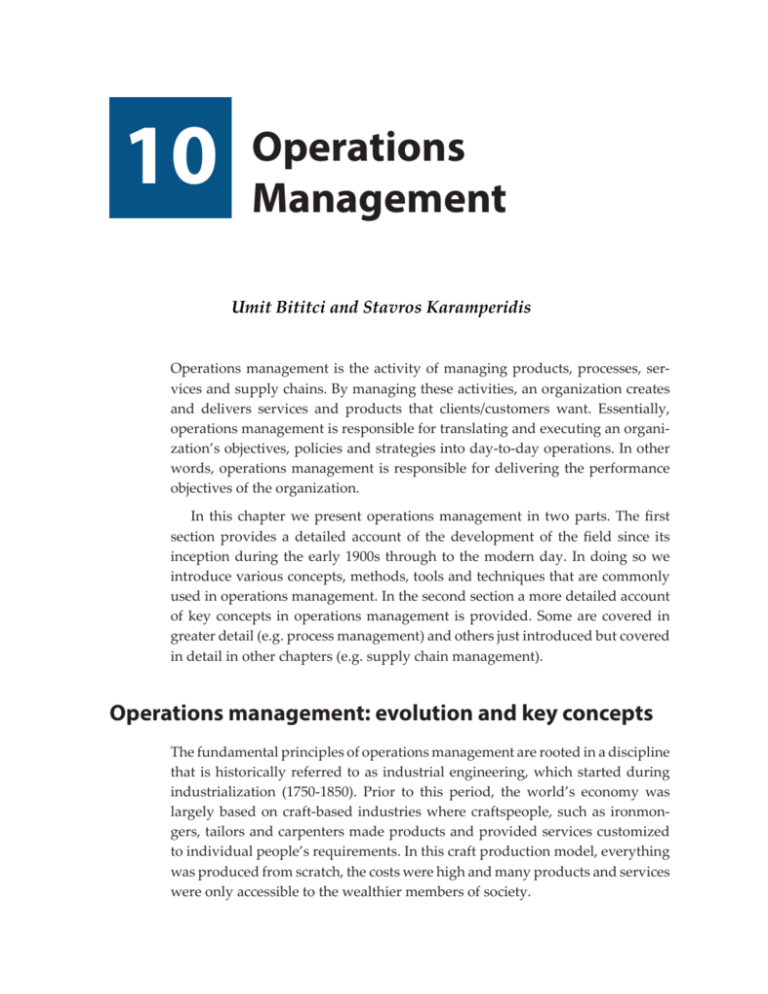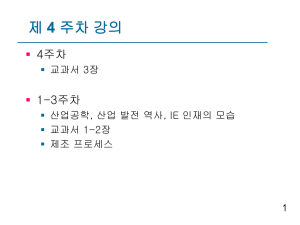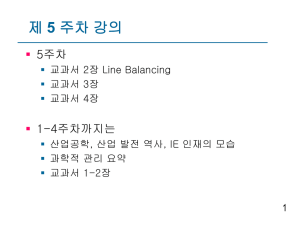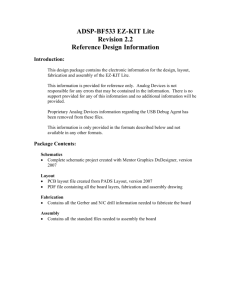10 Operations Management
advertisement

10 Operations Management Umit Bititci and Stavros Karamperidis Operations management is the activity of managing products, processes, services and supply chains. By managing these activities, an organization creates and delivers services and products that clients/customers want. Essentially, operations management is responsible for translating and executing an organization’s objectives, policies and strategies into day-to-day operations. In other words, operations management is responsible for delivering the performance objectives of the organization. In this chapter we present operations management in two parts. The first section provides a detailed account of the development of the field since its inception during the early 1900s through to the modern day. In doing so we introduce various concepts, methods, tools and techniques that are commonly used in operations management. In the second section a more detailed account of key concepts in operations management is provided. Some are covered in greater detail (e.g. process management) and others just introduced but covered in detail in other chapters (e.g. supply chain management). Operations management: evolution and key concepts The fundamental principles of operations management are rooted in a discipline that is historically referred to as industrial engineering, which started during industrialization (1750-1850). Prior to this period, the world’s economy was largely based on craft-based industries where craftspeople, such as ironmongers, tailors and carpenters made products and provided services customized to individual people’s requirements. In this craft production model, everything was produced from scratch, the costs were high and many products and services were only accessible to the wealthier members of society. 170 Enterprise and its Business Environment 170 The industrial revolution was born of technological advances which helped to make everyday products more accessible to the masses, hence the birth of the term mass manufacturing. The early stages of mass manufacturing are epitomized by the Ford Motor Company’s first product, the Ford Model-T, which you could buy in “any colour as long as it was black” (i.e. there was no choice for the consumer). These early stages of industrialization also led to development of management, and particularly operations management as a scientific discipline, as captured in F. W. Taylor’s book Principles of Scientific Management Introducing in a Global Context in 1911Management (Taylor, 2006). Today, the Toyota Production System is heralded as the best example of modern operations management, as described by the books entitled Machine That Changed the World (Womack, Jones and Roos, 2008) and Lean Thinking (Womack and Jones, 2010). Figure 10.1: From mass manufacturing (Ford Model-T) to lean manufacturing (Toyota production systems). Source: Toyota GB (2015) and Wikimedia Commons (2015). Early developments (1900-1940) During the early stages of industrialization and mass manufacturing, power lay largely with producers rather than customers. Firms produced what they thought would be appropriate for the market. Consumers had little if any choice; the norm was that you simply bought what was available. Taylor (2006), who undertook research into early factories and mass manufacturing, identified a key change in manufacturing processes, known as the production line concept. While in the pre-industrial revolution era, one person would produce the whole product, this new approach enabled the product to flow at a constant speed down the production line, where people with specialized skills and equipment would build a small and very specific part of the product. A production line allowed specialization of labour on one task (such as hanging a door on a car, sprinkling cheese on a pizza, sticking a label on a product). Specialization of labour was achieved by breaking complete jobs into smaller, repetitive component parts, which Adam Smith (1776) called “the division of labour”. This Operations Management 171 enabled people to get really good at doing a very specific task and led to huge productivity gains, at the price of more satisfying and skilled work. The main purpose of industrial engineering was to maximise the flow of work through the production line, i.e. make as many products as possible out of the same production line by improving the productivity1 of the production line. In order to achieve that, production engineering aimed to get as much value added work2 as possible from every unit of resource. For that reason, techniques such as work measurement and the method study were developed. Work measurement is concerned with the measurement of time needed to perform a job. It typically classifies tasks or activities in to value-adding or non-value adding activities and attempts to eliminate or minimise the non-value-adding activities. Method study is concerned with how various activities are organized, sequenced and integrated to ensure that the product is produced in the most efficient way. Method study and work measurement are often referred to collectively as work study. Work study helps to ensure the minimization of wasted time, by minimising non-value adding activities, thus increasing productivity. Exercise If you were managing a factory how would you measure production performance, and why? Increasing variety and competition (1940-1980) As the industrial era progressed further into the 20th century, the world economy started to improve; consumer buying power increased and some producers began to offer more choice as a means of securing an advantage. In contrast to the example of the single Model T Ford, General Motors sought to develop a product for every type of customer, through options that would allow customization. With increased choice, greater levels of uncertainty and complexity were introduced to the once simple production lines. Now production lines had to be designed to deal with a variety of products. This had a negative affect on both efficiency and productivity. Attention began to focus on layout planning to ensure that products flowed efficiently from one production area to another within the same factory. Layout planning is concerned with the organization of the production resources (i.e. machines, equipment, tooling and 1 Productivity is a measure of the efficiency of a production system. It can be expressed as the ratio of output to inputs used in the production process. 2 Value added work are the activities conducted by an organization in order to generate an output which is considered as more valuable by external customers than the inputs needed for its production. 10 172 Enterprise and its Business Environment 172 people) on the factory floor. Whilst the production line layout was considered to be most effective for producing a single product in large quantities with little or no variation (i.e. mass manufacturing), it proved less effective in dealing with increased variation, uncertainty and consumer choice. Alternative forms of shop floor organization emerged that included functional/process layout and later group technology (sometimes referred to as cellular manufacturing). Introducing Management in a Global Context Descriptions and illustrations for these alternative forms of shop floor organization are provided below. A Production/flow line layout is one where resources are organized in a line to enable the products to flow through the production system as efficiently as possible with minimum interruptions. Here, the focus is on the maximization of flow and thus productivity by balancing the work content of each work-station (line-balancing) along the production line. Typically, the production line lay out is suitable for low-variety high-volume manufacturing (Figure 10.2). Raw materials Bottles Corks Wine Labels Work station 1 Work station 2 Work station 3 Work station 4 Finished goods Figure 10.2: Flow line production Functional/process layout is where similar resources, activities or skills are grouped together into departments, such as welding department, painting department, machining department, finishing department. Here different products are routed through different departments according to their production requirements. Although highly flexible, these layouts do not have the productivity characteristics of flow line production as products have to travel from one resource to another. In operations management any unnecessary travel is considered as non-value adding and waste. Typically, functional/process layout is more suitable for small batch manufacturing normally characterized by highvariety and low-volumes.









![Traditional and Innovative Management Practices: Ford and Toyota [Name] [Class/Course]](http://s2.studylib.net/store/data/010303497_1-0118fe12204814f7b40c9437b6333566-300x300.png)